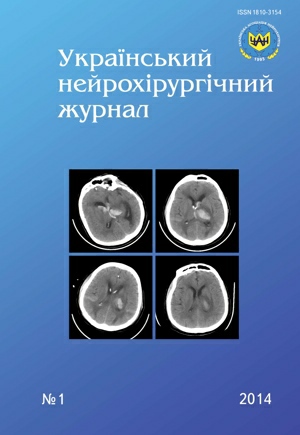Endovascular treatment of arteriovenous anastomoses in the cavernous sinus region
DOI:
https://doi.org/10.25305/unj.51537Keywords:
carotid-cavernous fistula, internal carotid artery, angiography, embolization, endovascular treatmentAbstract
Introduction. Arteriovenous fistula in the cavernous sinus is a complex vascular pathology of the brain, its’ treatment is a scabrous problem that requires optimization of used techniques.
Materials and methods. In the neurosurgical clinic of Kharkov Regional Hospital — Emergency and Disaster Medicine Center 23 endovascular surgeries were performed in 21 patients with carotid-cavernous sinus and arteriovenous fistulas. Preference was given to endovascular separation using detachable balloons «GoldBalloon» BALT (France).
Results. In 16 (76%) cases after endovascular surgery complete regression of ophthalmic disorders was observed. In 2 (9.5%) patients with indirect fistulas repeat embolization of external carotid artery branches was performed 6 months after first operation, complete regression of ophthalmic disorders was achieved.
Conclusions. The method of choice in treatment of arteriovenous fistulas of cavernous sinus is endovascular separation using modern materials and different adhesive compositions, which significantly increase treatment effectiveness in these patients.
References
1. Romodanov AP, Mosijchuk NM. Neyrokhirurgiya [Neurosurgery]. Kiev: Byshcha shk.; 1990. Russian.
2. Iakovlev SB. Arteriovenoznyye fistuly golovy i shei. Klinika, angioarkhitektonika, endovaskulyarnoye lecheniye [Arteriovenous fistula of head and neck. Clinic, angioarchitectonics, endovascular treatment] [dissertation]. Moscow (Russia): Burdenko Neurosurgery Institute; 2009. Russian.
3. Miller NR. Diagnosis and management of dural carotid-cavernous sinus fistulas. Neurosurg Focus. 2007;23(5):Е.13. [PubMed]
4. Serbinenko FA. [Occlusion of the cavernous portion of the carotid artery with a balloon as a method of treating carotid-cavernous anastomosis]. Vopr Neirokhir. 1971;35(6):3-9. Russian. [PubMed]
5. Tseng CH, Wu K-L, Tsai S-J, Lew HL. Development of сarotid сavernous fistula after traumatic brain injury. Am J Phys Med Rehabil. 2013;92(2):187-8. [PubMed] [CrossRef]
6. Luo CB, Teng MM, Chang FC, Sheu MH, Guo WY, Chang CY. Bilateral traumatic carotid-cavernous fistulae: strategies for endovascular treatment. Acta Neurochir (Wien). 2007;149(7):675-80. [PubMed] [CrossRef]
7. vanDijk JM, terBrugge KG, Willinsky RA, Wallace MC. Clinical course of cranial dural arteriovenous fistulas with long-term persistent cortical venous reflux. Stroke. 2002;33(5):1233-6. [PubMed] [CrossRef]
8. Shabarova AK, Kitar GA, Abulkhairova MA, Esetov EA, BAkhaev AN. Karotidno-kavernoznoye soust'ye (sluchay iz praktiki) [Carotid-cavernous fistula (case report)]. Oftalm Zhurn Kazakhstana. 2009;4:71-76. Russian.
9. Zozulia IuA, Shcheglov VI. [Experience with the use of intravascular interventions using a balloon catheter for several types of cerebral pathology]. Vopr Neirokhir. 1976;1:7-12. Russian. [PubMed]
10. Lucas CP, Zabramski JM, Spetzler RF, Jacobowitz R. Treatment for intracranial dural arteriovenous malformations: a meta-analysis from the English language literature. Neurosurgery. 1997;40(6):1119-32. [PubMed] [CrossRef]
11. Iakovlev SB, Bocharov AV, Bukharin EIu, Arustamian SP, Arkhangel'skaia IaN. [Direct carotid-cavernous fistulas: clinical presentation, angioarchitectonics and endovascular management]. Zh Vopr Neirokhir Im NN Burdenko. 2008;4:3-11. Russian. [PubMed]
12. Iakovlev SB, Bocharov AV, Bukharin EYu, Lysachev AG, Arustamian SR, Arkhangel’skaja IaN. Dural'nyye arteriovenoznyye fistuly. Etiologiya, patogenez, klinika, lecheniye [Dural arteriovenous fistula. Etiology, pathogenesis, clinical features, treatment]. In: Materials of the 2nd Internatiol School “Endovascular surgery for malformations and vascular disease of the brain”; 2007; Sankt-Peterburg, Russia. Sankt-Peterburg, 2007. p.109-10. Russian.
13. Kiyosue H, Hori Y, Okahara M, Tanoue S, Sagara Y, Matsumoto S, Nagatomi H, Mori H. Treatment of intracranial dural arteriovenous fistulas: current strategies based on location and hemodynamics, and alternative techniques of transcatheter embolization. Radiographics. 2004;24:1637-53. doi:10.1148/rg.246045026.
14. Cognard C, Januel AC, Silva NA Jr, Tall P. Endovascular treatment of intracranial dural arteriovenous fistulas with cortical venous drainage: new management using Onyx. Am J Neuroradiol. 2008;29(2):235-41. [PubMed] [CrossRef]
Downloads
Published
How to Cite
Issue
Section
License
Copyright (c) 2014 Vladimir Pyatikop, Yuri Kotlyarevskiy, Igor Kutovoy, Yuliya Sergienko, Anton Pshenichny, Andrey Naboychenko, Dmitriy Teslenko, Aleksandr Genkin

This work is licensed under a Creative Commons Attribution 4.0 International License.
Ukrainian Neurosurgical Journal abides by the CREATIVE COMMONS copyright rights and permissions for open access journals.
Authors, who are published in this Journal, agree to the following conditions:
1. The authors reserve the right to authorship of the work and pass the first publication right of this work to the Journal under the terms of Creative Commons Attribution License, which allows others to freely distribute the published research with the obligatory reference to the authors of the original work and the first publication of the work in this Journal.
2. The authors have the right to conclude separate supplement agreements that relate to non-exclusive work distribution in the form of which it has been published by the Journal (for example, to upload the work to the online storage of the Journal or publish it as part of a monograph), provided that the reference to the first publication of the work in this Journal is included.









